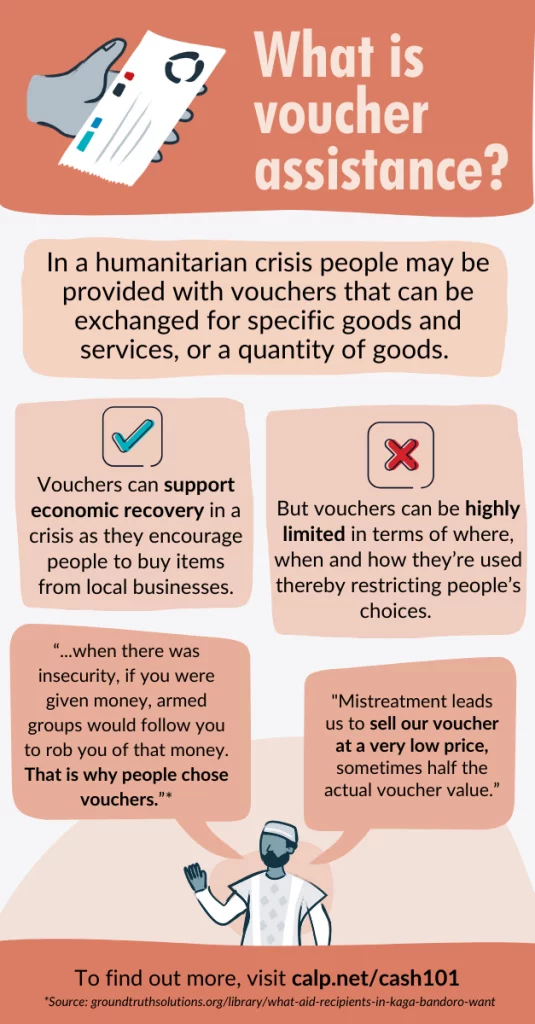Types of cash and voucher assistance (CVA)

Types of cash and voucher assistance (CVA)
Humanitarian cash and voucher assistance (CVA) refers to a form of aid provided in emergency or crisis situations to meet the basic needs of affected people. Instead of providing in-kind assistance such as food, shelter, blankets, etc. CVA involves providing cash or vouchers directly to individuals or households.
This approach allows people to make their own choices and prioritise their needs according to their specific circumstances, promoting dignity, empowerment, and supporting local market recovery.
What are the different types of Cash and Voucher Assistance?
There are two different types of cash and voucher assistance:
• A cash transfer is when money, either physical or digital, is provided to people affected by a humanitarian crisis.
• Vouchers are tokens that can be exchanged for a set value (e.g., 20 shillings), a set quantity (e.g., 5kgs rice) or type of goods or services (e.g., voucher for shelter materials).
The biggest difference for recipients is how restricted these two types of assistance are. Cash is unrestricted, so can be spent how a recipient chooses, whereas vouchers are limited in terms of where, when and how they can be used.
Depending on what is most appropriate for an individual humanitarian response, some programmes might attach conditions to either type of CVA. Conditional transfers are when the recipient must carry out an activity to receive assistance, for example, attending a nutrition screening. Whereas unconditional CVA is provided without the recipient needing to do anything.
What are cash transfers?
Cash transfers are a type of direct financial assistance for people affected by crises. Cash can be delivered to recipients either physically or electronically. All cash transfers are unrestricted, meaning recipients can choose how to spend the money (unlike vouchers which all have some form of restriction – see below).
Cash assistance can be designed in various ways, depending on the needs of the people affected by a crisis and the context. Here are a few types of cash assistance:
- Multipurpose cash assistance: Provides recipients with the amount of money required to cover their basic needs. They are multipurpose if they cover a number of needs.
- Unconditional cash transfers: Cash payments given without conditions, so recipients (who meet the programme’s targeting criteria), do not need to carry out any qualifying activities to receive assistance.
- Conditional cash transfers: When conditions are attached to receiving a cash transfer, such as building a shelter or receiving a vaccination. It is less common to use conditional cash transfers for a humanitarian response, they are more typically used to encourage behaviour that has longer-term benefits in social protection and development assistance.
Cash transfers can often be the fastest and most cost-effective way to reach people affected by a crisis. Here are some advantages of cash transfers:
- A World Bank review found that cash transfers – especially mobile money transfers – are cheaper to deliver than in-kind transfers in humanitarian settings.
- Cash transfers can increase food security and resilience to shocks for people in a humanitarian crisis. GiveDirectly, UNHCR, and Government of Rwanda found that refugees in Rwanda were able to use cash transfers as a coping mechanism to cover immediate needs during the Covid-19 pandemic.
While cash transfers are often an effective type of humanitarian assistance, they might not always be appropriate for a response. The right conditions must be in place, for example there must be functioning markets where people can buy the goods they need. Careful analysis of the context and needs of the people affected by crisis should be carried out to decide on the best type of response.
Find out more about cash transfers on Cash 101.
What is multipurpose cash assistance
Multipurpose cash assistance (MPC) cash transfer that provides the amount of money that fully or partially meets the basic needs of an individual or household affected by a crisis.
A cash payment is ‘multipurpose’ if it is explicitly designed to meet multiple needs (such as shelter, livelihoods, sanitation facilities, health, water, food, education and shelter). All MPCs are unrestricted and people can spend the money on what they choose.
The amount of money a household will receive with a multipurpose cash assistance is usually calculated based on how much they need to cover their basic needs. A Minimum Expenditure Basket (MEB), or other monetized calculation, will be used to calculate the payments needed to cover basic needs. For more information on how MEBs are calculated, visit CALP’s Calculating the Minimum Expenditure Basket: A Guide to Best Practice.
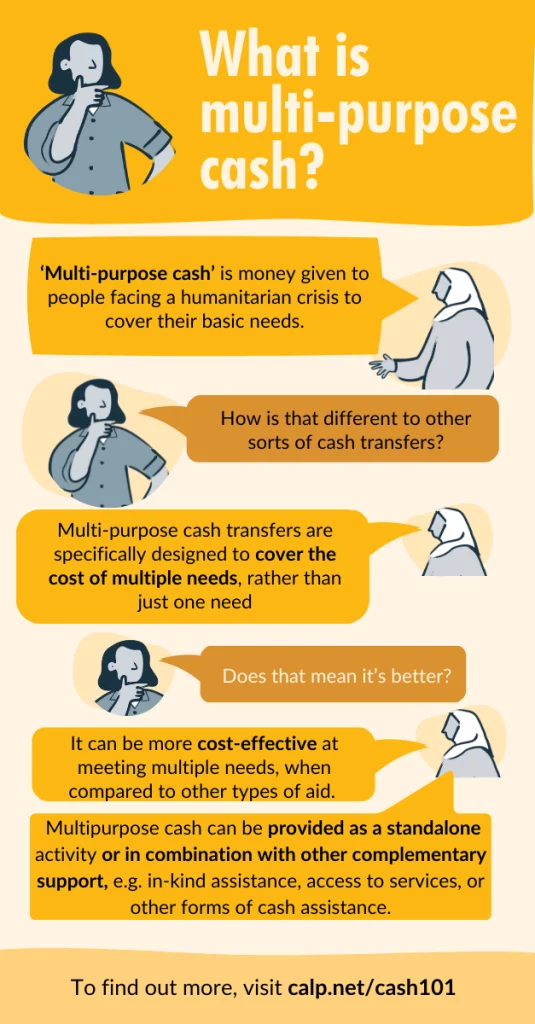
Read more about multipurpose cash on the Cash 101.
What are unconditional cash transfers?
An unconditional cash transfer is a direct payment given to people affected by a humanitarian crisis without them having to do anything to receive the assistance, other than meet the programmes targeting criteria. Unconditional cash transfers are more common than conditional cash transfers in humanitarian response.
Unconditional cash transfers can help improve food security and reduce the use of negative coping strategies. The Emergency Social Safety Net (ESSN) found that providing unconditional cash transfers to vulnerable Syrian refugees in Turkey caused a sharp decline in poverty and inequality, as well as improving food security and diversity of diets during the period of the programme.
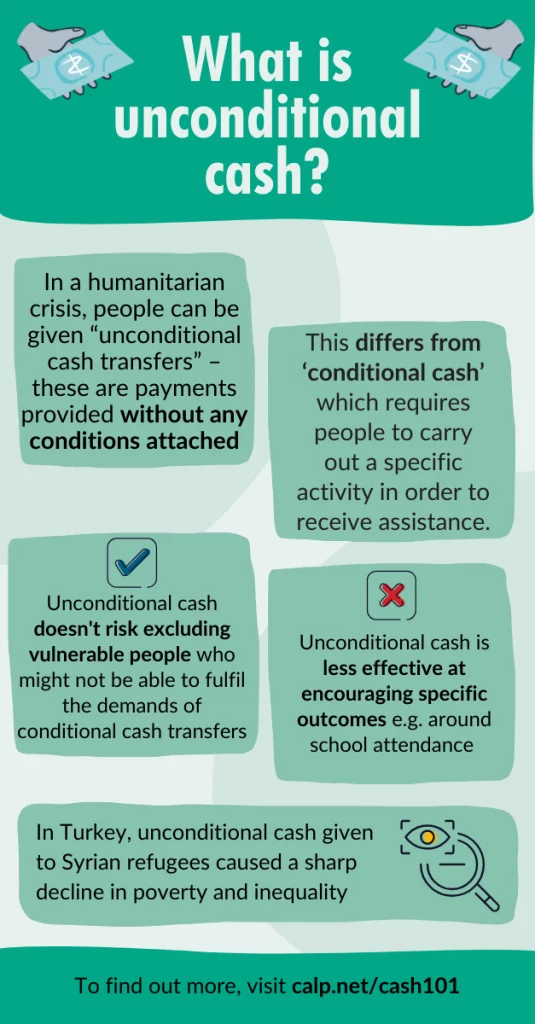
Find out more about unconditional cash transfers on Cash 101.
What are conditional cash transfers?
Conditional cash transfers are a type of cash and voucher assistance where money is given to people affected by crises on the condition that they carry out certain activities.
For example, recipients might carry out cash for work, where cash payments are given on the condition that they carry out a designated activity. People might be paid for the number of hours worked at a daily rate or for carrying out a specific task (such as clearing roads after a disaster).
Other examples of humanitarian conditional cash transfers are when cash is given on condition that a recipient attends a training, receives a nutrition screening, or enrols their children in school.
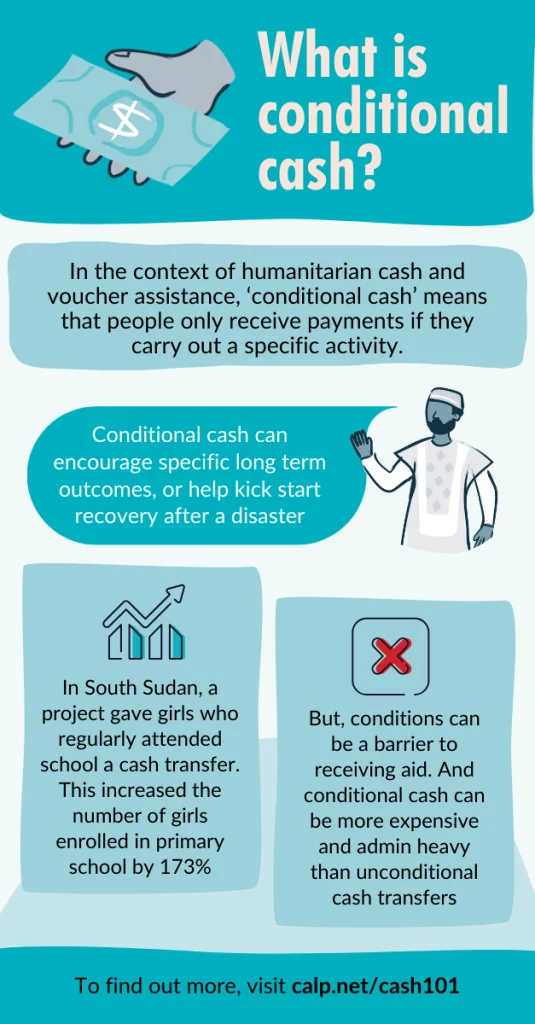
To find out more, visit the conditional cash transfers page.
What are vouchers?
Vouchers are a type of CVA given to people affected by a crisis that can be exchanged for a set value (e.g., 1,000 Yen), a set quantity (e.g., 2 kilos of rice) or type of goods or service. Unlike cash, they are by default a restricted type of assistance as they can only be used on certain items or services. Vouchers can often only be used with pre-determined vendors.
There are two main types of vouchers:
- Commodity vouchers can be exchanged for specific goods or services. The goods or services normally have a set value and provide basic needs, such as 5kg of rice or building a shelter.
- Value vouchers have a cash value and can be used to buy items or services from specified vendors. These vouchers tend to provide more flexibility than commodity vouchers as people have more choice over what they buy, even if it is still restricted to certain products and services.
The main benefit of vouchers is that they help support economic recovery following a crisis by encouraging people to buy items from local businesses. Often this type of assistance will go hand in hand with programmes to help local businesses rebuild stocks and ensure supplies are locally available.
On the other hand, vouchers have been criticised as being too restrictive, undignified, and open to exploitation.
People often sell their vouchers for a lower cash amount than the value of the voucher, wasting precious resources that could be better spent elsewhere. It’s been reported that women have sometimes been pressured to sell their vouchers at a lower price due to power imbalances.
Because the vouchers are restricted to certain vendors, recipients have also complained that they are stuck with the service and product, even if it’s a lower quantity or lacks the quality advertised.
Comparing cash, vouchers and in-kind goods and services
Cash, vouchers and in-kind aid in the form of goods and services are four different types of humanitarian assistance. Humanitarian actors consider the specific needs of people in an individual crisis to decide which type of aid is most appropriate and effective for a specific response.
Cash is more flexible, cost-efficient, and typically preferred by people affected by crisis. However, the right conditions need to be in place for cash to be appropriate and feasible.
In comparison, in-kind assistance (food and non-food items) offers limited choice for recipients, with decision making typically handled by humanitarians based on overall assessments.
At times, in-kind aid might be more appropriate when the goods or food people need are not available locally.
Voucher assistance offers less flexibility than cash but can provide more freedom to choose than in-kind aid. It can also have other benefits, such as kick-starting the local market after a crisis has impacted its functioning.
CALP’s pre-condition checklist outlines four areas that should be considered before deciding if CVA is the right response for a context, including the right market conditions, safe and reliable operational conditions, recipient needs and preferences, and community and political acceptance of cash.
Find out more about which assistance to use on our page comparing cash transfers, in-kind assistance and vouchers on the Cash 101.
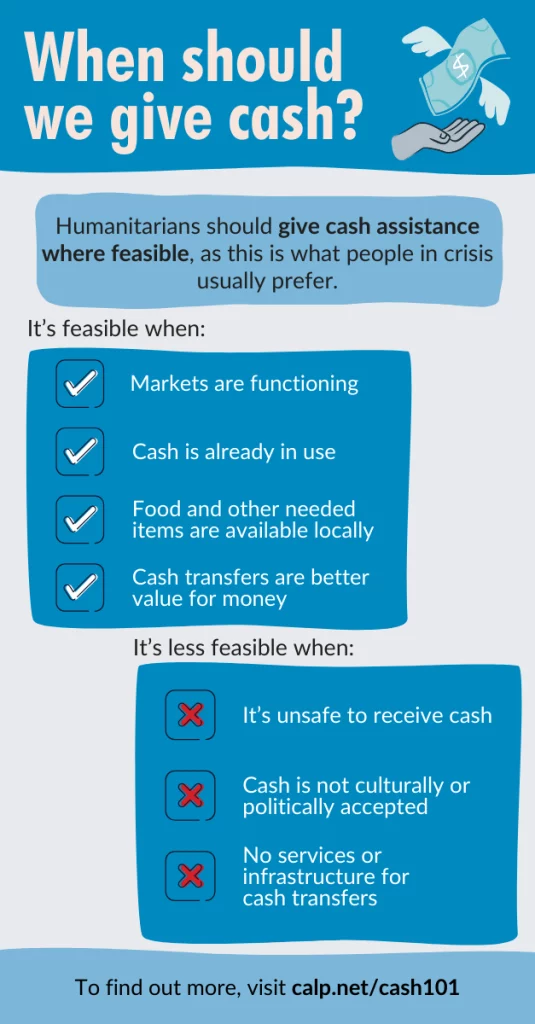
Integrated programming and Cash Plus
Although these terms can be used interchangeably, integrated programming and Cash Plus are distinct from one another. Complementary programming is yet another related – yet distinct – concept.
Integrated programming in humanitarian action combines the use of different types of programming or activities to address the needs of people affected by crises. CVA can be one part of a holistic integrated programme, which can combine humanitarian sectors and types of assistance to provide a people-centred response.
Integrated programmes might involve several humanitarian actors working collaboratively towards the same goal, or one organisation working with multiple objectives and departments.
Cash plus is an approach that combines cash transfers with complementary interventions. Cash plus implies that cash is the core component, with other things added – this is what sets it apart from complementary programming which is considered to be more neutral in its approach.
Cash Plus is a type of complementary programming that combines cash transfers with other types of support. By combining programmes in a response, it can potentially improve longer-term impacts such as nutrition – particularly in protracted crises.
For example, a Cash Plus programme designed to support conflict-affected communities in Yemen found that combining cash transfers and nutritional education had a positive impact on maternal and child dietary diversity and children’s height and weight measures. The programme may also significantly decrease the likelihood of children being diagnosed with moderate or severe acute malnutrition.
To find out more, visit Integrated programming and Cash Plus on Cash 101.
